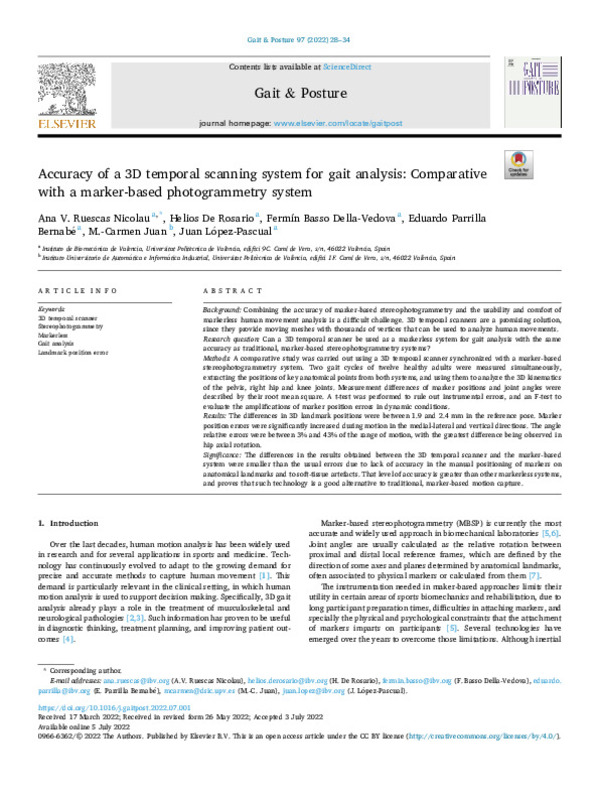JavaScript is disabled for your browser. Some features of this site may not work without it.
Buscar en RiuNet
Listar
Mi cuenta
Estadísticas
Ayuda RiuNet
Admin. UPV
Accuracy of a 3D temporal scanning system for gait analysis: Comparative with a marker-based photogrammetry system
Mostrar el registro sencillo del ítem
Ficheros en el ítem
| dc.contributor.author | RUESCAS NICOLAU, ANA VIRGINIA
|
es_ES |
| dc.contributor.author | De Rosario Martínez, Helios
|
es_ES |
| dc.contributor.author | Basso Della-Vedova, Fermín
|
es_ES |
| dc.contributor.author | Parrilla Bernabé, Eduardo
|
es_ES |
| dc.contributor.author | Juan, M.-Carmen
|
es_ES |
| dc.contributor.author | Lopez Pascual, Juan
|
es_ES |
| dc.date.accessioned | 2023-12-05T19:03:41Z | |
| dc.date.available | 2023-12-05T19:03:41Z | |
| dc.date.issued | 2022-09 | es_ES |
| dc.identifier.issn | 0966-6362 | es_ES |
| dc.identifier.uri | http://hdl.handle.net/10251/200527 | |
| dc.description.abstract | [EN] Background Combining the accuracy of marker¿based stereophotogrammetry and the usability and comfort of markerless human movement analysis is a difficult challenge. 3D temporal scanners are a promising solution, since they provide moving meshes with thousands of vertices that can be used to analyze human movements. Research question Can a 3D temporal scanner be used as a markerless system for gait analysis with the same accuracy as traditional, marker¿based stereophotogrammetry systems? Methods A comparative study was carried out using a 3D temporal scanner synchronized with a marker¿based stereophotogrammetry system. Two gait cycles of twelve healthy adults were measured simultaneously, extracting the positions of key anatomical points from both systems, and using them to analyze the 3D kinematics of the pelvis, right hip and knee joints. Measurement differences of marker positions and joint angles were described by their root mean square. A t¿test was performed to rule out instrumental errors, and an F¿test to evaluate the amplifications of marker position errors in dynamic conditions. Results The differences in 3D landmark positions were between 1.9 and 2.4 mm in the reference pose. Marker position errors were significantly increased during motion in the medial¿lateral and vertical directions. The angle relative errors were between 3% and 43% of the range of motion, with the greatest difference being observed in hip axial rotation. Significance The differences in the results obtained between the 3D temporal scanner and the marker¿based system were smaller than the usual errors due to lack of accuracy in the manual positioning of markers on anatomical landmarks and to soft¿tissue artefacts. That level of accuracy is greater than other markerless systems, and proves that such technology is a good alternative to traditional, marker¿based motion capture. | es_ES |
| dc.description.sponsorship | Activity developed within the framework of the IBERUS project. Technological Network of Biomedical Engineering applied to degenerative pathologies of the neuromusculoskeletal system in clinical and outpatient settings (CER-20211003), CERVERA Network financed by the Ministry of Science and Innovation through the Center for Industrial Technological Development (CDTI), charged to the General State Budgets 2021 and the Recovery, Transformation and Resilience Plan. | es_ES |
| dc.language | Inglés | es_ES |
| dc.publisher | Elsevier | es_ES |
| dc.relation.ispartof | Gait & Posture | es_ES |
| dc.rights | Reconocimiento (by) | es_ES |
| dc.subject | 3D temporal scanner | es_ES |
| dc.subject | Stereophotogrammetry | es_ES |
| dc.subject | Markerless, Gait analysis | es_ES |
| dc.subject | Landmark position error | es_ES |
| dc.subject.classification | LENGUAJES Y SISTEMAS INFORMATICOS | es_ES |
| dc.title | Accuracy of a 3D temporal scanning system for gait analysis: Comparative with a marker-based photogrammetry system | es_ES |
| dc.type | Artículo | es_ES |
| dc.identifier.doi | 10.1016/j.gaitpost.2022.07.001 | es_ES |
| dc.relation.projectID | info:eu-repo/grantAgreement/CDTI//CER-20211003/ | es_ES |
| dc.rights.accessRights | Abierto | es_ES |
| dc.contributor.affiliation | Universitat Politècnica de València. Escuela Técnica Superior de Ingenieros Industriales - Escola Tècnica Superior d'Enginyers Industrials | es_ES |
| dc.contributor.affiliation | Universitat Politècnica de València. Instituto Universitario Mixto de Biomecánica de Valencia - Institut Universitari Mixt de Biomecànica de València | es_ES |
| dc.description.bibliographicCitation | Ruescas Nicolau, AV.; De Rosario Martínez, H.; Basso Della-Vedova, F.; Parrilla Bernabé, E.; Juan, M.; Lopez Pascual, J. (2022). Accuracy of a 3D temporal scanning system for gait analysis: Comparative with a marker-based photogrammetry system. Gait & Posture. 97:28-34. https://doi.org/10.1016/j.gaitpost.2022.07.001 | es_ES |
| dc.description.accrualMethod | S | es_ES |
| dc.relation.publisherversion | https://doi.org/10.1016/j.gaitpost.2022.07.001 | es_ES |
| dc.description.upvformatpinicio | 28 | es_ES |
| dc.description.upvformatpfin | 34 | es_ES |
| dc.type.version | info:eu-repo/semantics/publishedVersion | es_ES |
| dc.description.volume | 97 | es_ES |
| dc.identifier.pmid | 35868094 | es_ES |
| dc.relation.pasarela | S\471614 | es_ES |
| dc.contributor.funder | Centro para el Desarrollo Tecnológico Industrial | es_ES |








